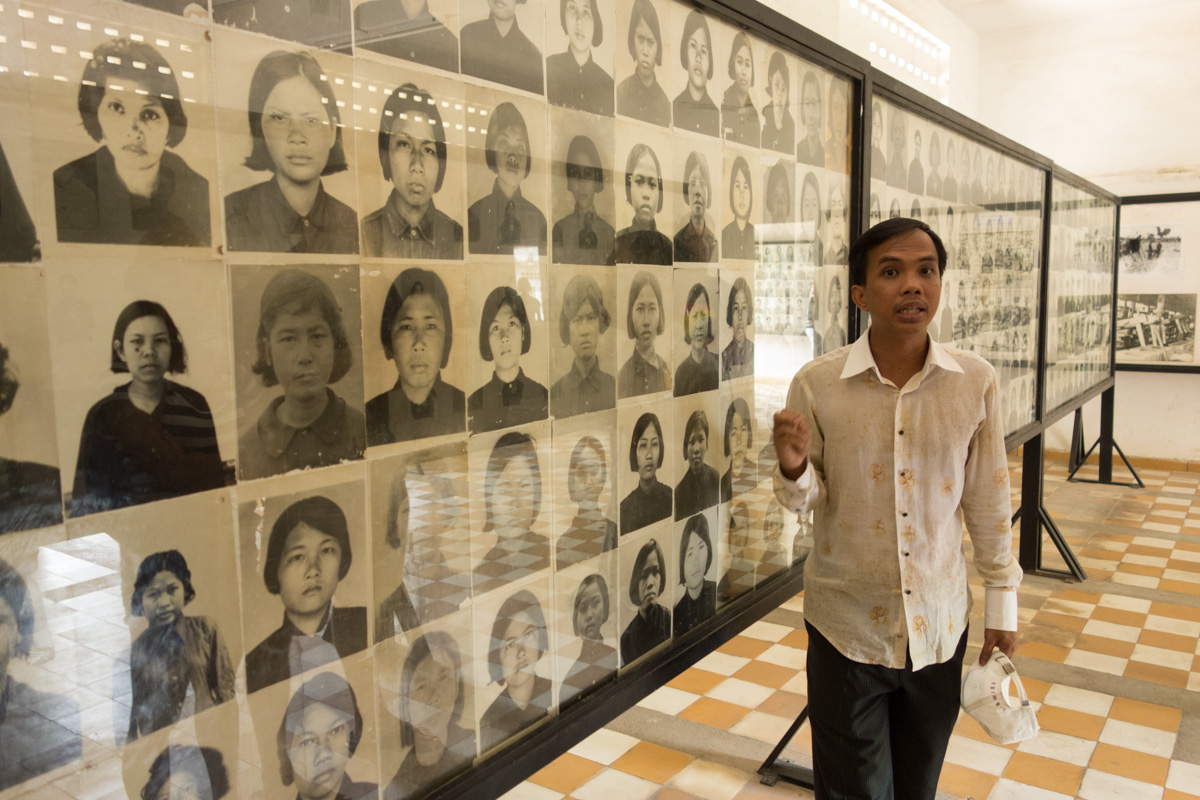We had originally planned to fly straight into Siem Reap, Cambodia from Bangkok, but the ticket price was ridiculous, so we decided to stop by Phnom Penh, the capital city of Cambodia.
Since we didn’t do much research before we got here, it was not exactly what I imagined a country’s capital would look like, especially coming from the modern metropolis of Bangkok. We arrived in the evening, and from the airport through the city, to our accommodation on the Mekong River delta, there were no skyscrapers or highway bridges to be found, and the only neon lights we saw hung dimly above one story karaoke bars and massage parlors.
Our hotel was far from the center of town, and since my cold has flared up, I opted to stay in while everyone else ventured out for dinner. So I missed this wonderful part of the trip:
I’m not sure how I feel about having live tarantulas crawl all over me or eating them, but I’m rather sad that I missed watching them crawl all over my friends! As an added bonus, here a picture of said tarantula being eaten.
There isn’t much to see in Phnom Penh, and it’s mostly due to a genocide that happened much more recent than one might want to believe. In 1975, a civil war in Cambodia ended with the Khmer Rouge party gaining control of the country. During the four years that followed, an estimated 2 million people died execution, starvation, and forced labor — out of a total population of less than 8 million. City dwellers were driven out to work on collective farms, schools were shut down, professionals and foreigners were executed, religion was banned. An infamous Pol Pot (the head of Khmer Rouge at the time) quote summarized the official position well: “to spare you is no profit, to destroy you is no loss.”
Rather than another botanical garden, zoo, or art museum, we spent the day learning the history of Cambodia’s war and the dictator who caused the turmoil for its people. The killing field of Choeung Ek, one of many all over the country, is just an hour outside of the city. Once a place where the innocent victims were butchered to death, it now serves as a place for the living to remember. The museum is simply laid out, and a free audio guided tour explains the atrocities that were committed here, even though little evidence can be seen now.
There was one exhibit that brought many guests to tears, and that’s the killing tree. The executioners did not have enough bullets to kill the people brought to the killing fields, and an examination of the skeletal remains shows that most of the victims died by hatchet strikes to the head. But for the most innocent and vulnerable victims, babies and toddlers, many were thrown against this tree with their parents watching. Today, this tree is adorned with bracelets and ribbons, gifts from visitors around the world who may not ever have even known about the war before they came here.
One part of the audio tour was a solemn yet beautiful orchestral piece written for the victims. As we sat on the small wooden benches next to the wired fences separating the memorial site from the lush green farmlands outside, it was difficult to connect the serenity of the surroundings to the horrors of the past.
On our way back to the city, we stopped at S21, the prison where many high profile prisoners were tortured and killed.
The prison was originally a high school, and the cells were converted from classrooms.
After the prisoners arrive, they were photographed, forced to give an autobiography, then stripped down and sent to their cells. 
The high ranking politicians were given their own rooms, and the rest were shackled together and shoved into small cells separated by thin walls.
 Our tour guide took us around the different rooms, one of which still had the blood stain on the ceiling, from the splash caused by the final murder committed there.
Our tour guide took us around the different rooms, one of which still had the blood stain on the ceiling, from the splash caused by the final murder committed there.
We asked our guide about his own experience, and he told us that almost all people had family members and friends who died during the genocide. After all, a quarter of the entire population of Cambodia was wiped out in the period of 4 years. We then asked how he felt knowing that the murderers still lived among them, and probably won’t ever be prosecuted. Even the main perpetrator, Pol Pot, died a peaceful death at the age of 73, never even seeing the inside of a prison cell. He paused and responded, Cambodians are mostly Buddhist, and we are a peaceful people. We’ve been in a war for so long, so many people died, so now we just want peace. We can hold onto the anger and find the murderers, and kill more people, but it would just prolong the war and create more pain and suffering. You’ve seen our cities, we are poor and have much work to do, so we just want to rebuild our country and our culture. We don’t want revenge, and we only built this museum to remind people what happened so it won’t happen again.
Our visit to Phnom Penh was short and somber. As we left the city on a crowded bus, watching people on busy streets going about normal days, I had a new sense of respect for this country and its people. Their faces seemed weary but content. After all, these are people carrying the burden of a lost generation and the hopes of building a bright future for the next one.














Leave a Reply